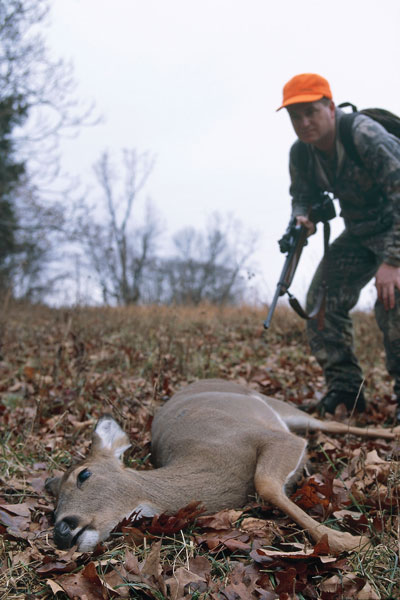A healthy doe steps into the field just 20 yards from your stand, turns broadside and puts her nose into the clover. It’s the perfect shot and the perfect opportunity to put that first deer in the freezer. So you raise your bow, draw and find her front shoulder through the peep sight without even thinking about the possibility of fawns.
Just before you touch the trigger on your release, the doe looks over her shoulder and you hear a twig snap back in the woods. Could it be that giant 8-point you’ve been watching all summer?
Nope. A fawn steps out, eases up to the doe and starts grazing. For some, the decision to shoot that doe just became a little more difficult. The fawn doesn’t have spots and it’s eating the same thing as its mother, but you just aren’t sure. Shooting a doe with a fawn to some seems like an ethical dilemma: Will killing the mother leave the fawn orphaned and less likely to survive?
“In most cases, no,” says Brian Murphy, executive director of the Quality Deer Management Association. “Most states set their seasons so orphaned fawns are capable of surviving on their own, so it’s not really an ethical issue. However, there are some states that have late fawning periods and early bow seasons where it could present problems.”
That’s most likely to happen in regions of the Deep South where the rut is drawn out over months or takes place far later than the rest of the country. In some instances, fawns are born as late as July and are just a few months old in the early days of bow season.
Fawns and survival?
It takes about three months for a fawn to be completely weaned, although Dr. Charles deYoung, a biologist at the Caesar Kleberg Wildlife Research Institute in Texas, says it usually takes only about two months before a fawn can survive without its mother. He did note that fawns that don’t have access to their mother’s milk all three months often end up somewhat less healthy on average as adults, and typically weigh less than fawns of equal age that aren’t orphaned. In order to give fawns their fullest potential, Mississippi sets its antlerless seasons later to allow fawns to complete that weaning period.
Even if they will probably survive, orphaned fawns aren’t completely safe. A study conducted in Texas found that motherless fawns are more prone to predation, Murphy said, possibly because they haven’t been taught that coyotes and other major predators rep resent danger. As coyote numbers climb in Eastern states and wolf numbers increase in the northern and Rocky Mountain states, the predation factor might become an issue in those parts of the country, as well.
resent danger. As coyote numbers climb in Eastern states and wolf numbers increase in the northern and Rocky Mountain states, the predation factor might become an issue in those parts of the country, as well.
If nothing else, they might complicate management efforts, but coyote predation on orphaned fawns in the east and southeast can be a good thing from a biologist’s perspective, because taking more deer than fewer is good. Most eastern and southeastern states have far too many whitetails in some regions, and hunters aren’t taking enough to help control them.
The Cutoff?
As the season progresses, the potential problems of taking a doe with a fawn at her side become fewer. Not only will that fawn be able to survive just fine without its mother, but it also will probably have learned all the survival instincts it can by then. Murphy, however, said if you have a choice, shoot a doe with a buck fawn instead of a young female at its side.
“There was a study done in Georgia that looked at dispersal rates among young bucks that did not have their maternal does," he said. "Basically, it found that if the mother was dead or missing, the buck was far less likely to leave its birth home range. It’s difficult to tell the difference under low-light conditions, but if you have time and you can look closely, I’d go for the doe with the button buck by her side.”
Normally, about one-quarter of buck fawns are kicked out of their mother’s home range in the spring; the rest are forced to leave by their maternal doe the next fall. But with no mother to urge them to leave, those bucks are far more likely to stick around and set up their home turf where they were born — on your land.
“It makes it easier to manage young bucks,” adds Murphy.
The bottom line? Don’t hesitate to shoot a doe leading a fawn if it fits into your management plan, or if you simply want to kill it for the meat. Murphy suggests taking younger does if your main concern is stocking your freezer. Not only do they taste better, they are more expendable and typically produce fewer fawns than older does.
By leaving the more productive females, you help boost buck numbers down the road. Of course, managing your deer herd is a continuous process and shooting does will always be part of any sound management plan. But shooting a doe standing next to her fawn might pose an ethical dilemma for some hunters.
“If a fawn looks too small, less than 40 or 45 pounds, and you aren’t sure, play it safe and hold off until a doe with an older fawn presents a shot,” he said. “If it makes you feel better, then that’s what you should do.”






